Benefits and Risks of POS System Implementation in Business
VerifiedAdded on 2023/06/11
|11
|2529
|52
AI Summary
This report discusses the benefits and risks of implementing a POS system in a business, including a case study of its successful implementation. It covers advantages such as accuracy, reliability, and centralized databases, as well as disadvantages such as high costs and risks to security, privacy, and confidentiality. The report also explores how a POS system can help businesses gain a competitive advantage and facilitate decision making. Telecommunication options and measures to protect against risks are also discussed.
Contribute Materials
Your contribution can guide someone’s learning journey. Share your
documents today.

it for business
POS System
[DATE]
Student details
Email ID:
POS System
[DATE]
Student details
Email ID:
Secure Best Marks with AI Grader
Need help grading? Try our AI Grader for instant feedback on your assignments.
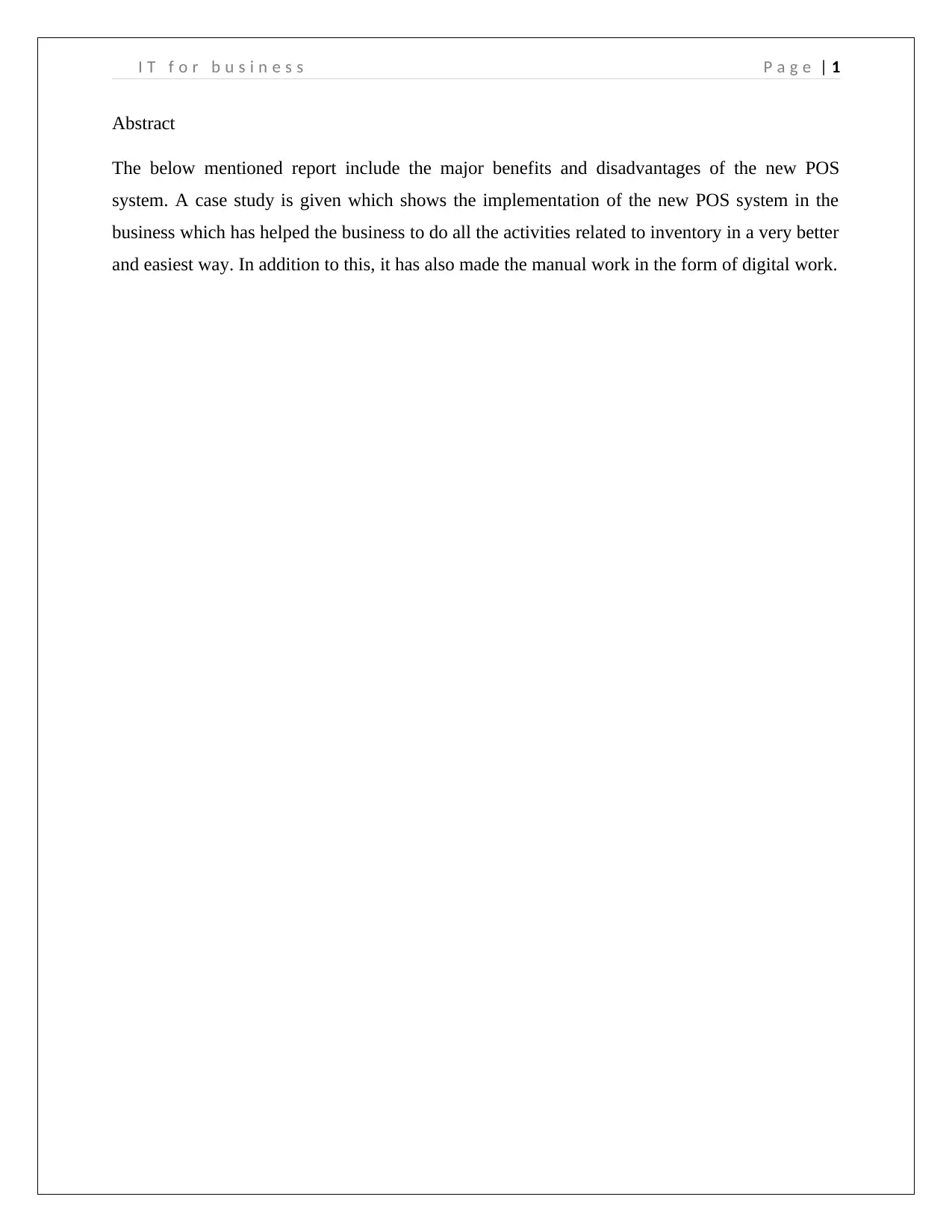
I T f o r b u s i n e s s P a g e | 1
Abstract
The below mentioned report include the major benefits and disadvantages of the new POS
system. A case study is given which shows the implementation of the new POS system in the
business which has helped the business to do all the activities related to inventory in a very better
and easiest way. In addition to this, it has also made the manual work in the form of digital work.
Abstract
The below mentioned report include the major benefits and disadvantages of the new POS
system. A case study is given which shows the implementation of the new POS system in the
business which has helped the business to do all the activities related to inventory in a very better
and easiest way. In addition to this, it has also made the manual work in the form of digital work.
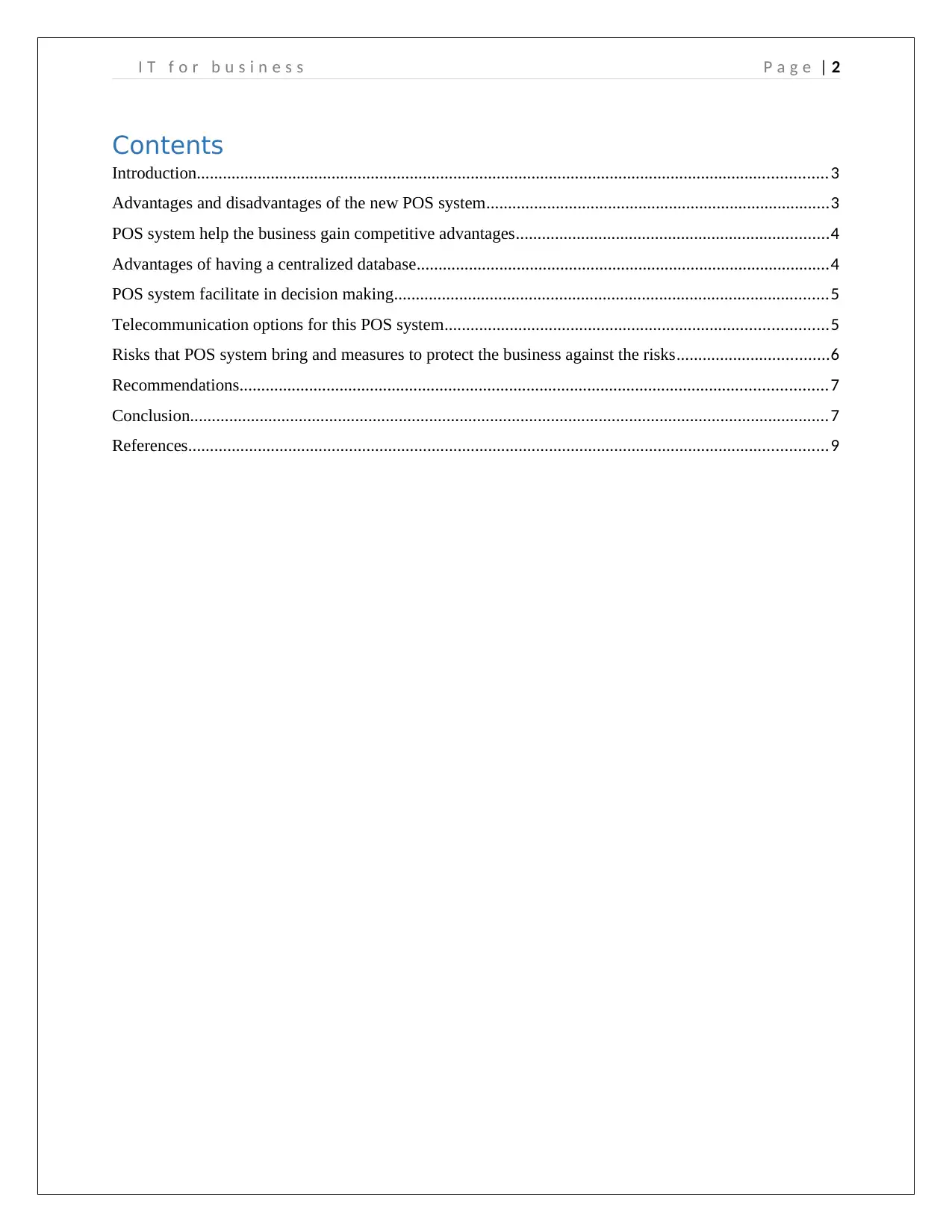
I T f o r b u s i n e s s P a g e | 2
Contents
Introduction.................................................................................................................................................3
Advantages and disadvantages of the new POS system...............................................................................3
POS system help the business gain competitive advantages........................................................................4
Advantages of having a centralized database...............................................................................................4
POS system facilitate in decision making....................................................................................................5
Telecommunication options for this POS system........................................................................................5
Risks that POS system bring and measures to protect the business against the risks...................................6
Recommendations.......................................................................................................................................7
Conclusion...................................................................................................................................................7
References...................................................................................................................................................9
Contents
Introduction.................................................................................................................................................3
Advantages and disadvantages of the new POS system...............................................................................3
POS system help the business gain competitive advantages........................................................................4
Advantages of having a centralized database...............................................................................................4
POS system facilitate in decision making....................................................................................................5
Telecommunication options for this POS system........................................................................................5
Risks that POS system bring and measures to protect the business against the risks...................................6
Recommendations.......................................................................................................................................7
Conclusion...................................................................................................................................................7
References...................................................................................................................................................9
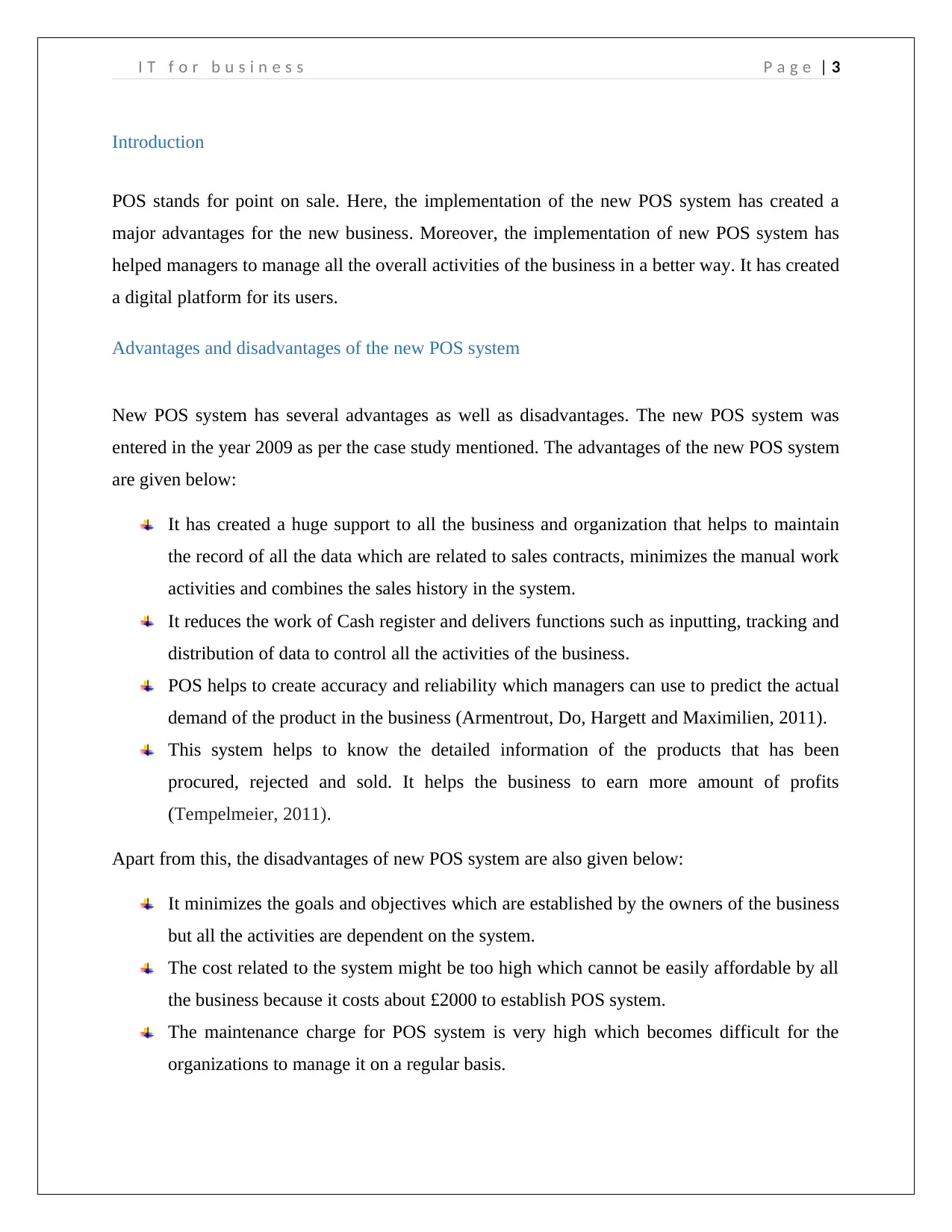
I T f o r b u s i n e s s P a g e | 3
Introduction
POS stands for point on sale. Here, the implementation of the new POS system has created a
major advantages for the new business. Moreover, the implementation of new POS system has
helped managers to manage all the overall activities of the business in a better way. It has created
a digital platform for its users.
Advantages and disadvantages of the new POS system
New POS system has several advantages as well as disadvantages. The new POS system was
entered in the year 2009 as per the case study mentioned. The advantages of the new POS system
are given below:
It has created a huge support to all the business and organization that helps to maintain
the record of all the data which are related to sales contracts, minimizes the manual work
activities and combines the sales history in the system.
It reduces the work of Cash register and delivers functions such as inputting, tracking and
distribution of data to control all the activities of the business.
POS helps to create accuracy and reliability which managers can use to predict the actual
demand of the product in the business (Armentrout, Do, Hargett and Maximilien, 2011).
This system helps to know the detailed information of the products that has been
procured, rejected and sold. It helps the business to earn more amount of profits
(Tempelmeier, 2011).
Apart from this, the disadvantages of new POS system are also given below:
It minimizes the goals and objectives which are established by the owners of the business
but all the activities are dependent on the system.
The cost related to the system might be too high which cannot be easily affordable by all
the business because it costs about £2000 to establish POS system.
The maintenance charge for POS system is very high which becomes difficult for the
organizations to manage it on a regular basis.
Introduction
POS stands for point on sale. Here, the implementation of the new POS system has created a
major advantages for the new business. Moreover, the implementation of new POS system has
helped managers to manage all the overall activities of the business in a better way. It has created
a digital platform for its users.
Advantages and disadvantages of the new POS system
New POS system has several advantages as well as disadvantages. The new POS system was
entered in the year 2009 as per the case study mentioned. The advantages of the new POS system
are given below:
It has created a huge support to all the business and organization that helps to maintain
the record of all the data which are related to sales contracts, minimizes the manual work
activities and combines the sales history in the system.
It reduces the work of Cash register and delivers functions such as inputting, tracking and
distribution of data to control all the activities of the business.
POS helps to create accuracy and reliability which managers can use to predict the actual
demand of the product in the business (Armentrout, Do, Hargett and Maximilien, 2011).
This system helps to know the detailed information of the products that has been
procured, rejected and sold. It helps the business to earn more amount of profits
(Tempelmeier, 2011).
Apart from this, the disadvantages of new POS system are also given below:
It minimizes the goals and objectives which are established by the owners of the business
but all the activities are dependent on the system.
The cost related to the system might be too high which cannot be easily affordable by all
the business because it costs about £2000 to establish POS system.
The maintenance charge for POS system is very high which becomes difficult for the
organizations to manage it on a regular basis.
Secure Best Marks with AI Grader
Need help grading? Try our AI Grader for instant feedback on your assignments.
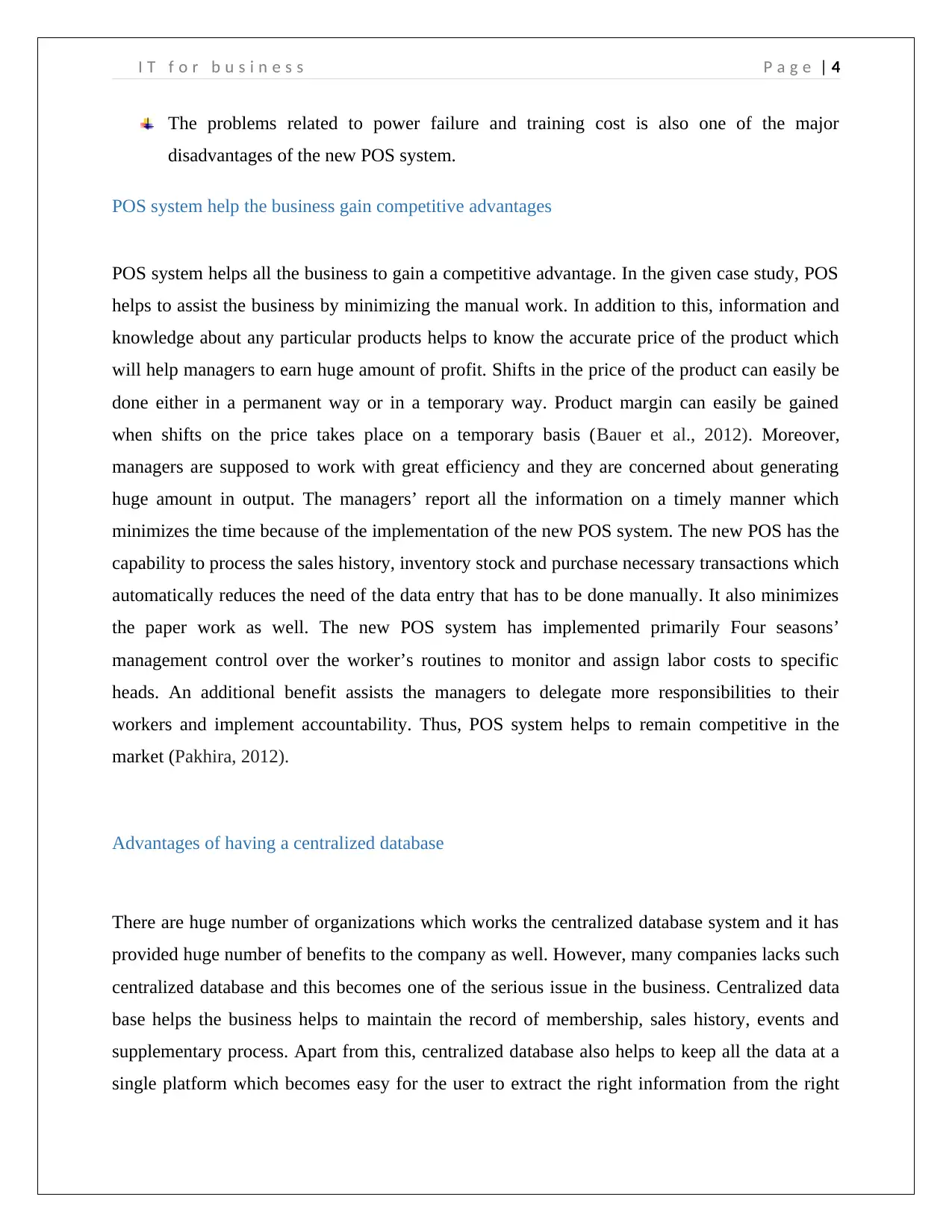
I T f o r b u s i n e s s P a g e | 4
The problems related to power failure and training cost is also one of the major
disadvantages of the new POS system.
POS system help the business gain competitive advantages
POS system helps all the business to gain a competitive advantage. In the given case study, POS
helps to assist the business by minimizing the manual work. In addition to this, information and
knowledge about any particular products helps to know the accurate price of the product which
will help managers to earn huge amount of profit. Shifts in the price of the product can easily be
done either in a permanent way or in a temporary way. Product margin can easily be gained
when shifts on the price takes place on a temporary basis (Bauer et al., 2012). Moreover,
managers are supposed to work with great efficiency and they are concerned about generating
huge amount in output. The managers’ report all the information on a timely manner which
minimizes the time because of the implementation of the new POS system. The new POS has the
capability to process the sales history, inventory stock and purchase necessary transactions which
automatically reduces the need of the data entry that has to be done manually. It also minimizes
the paper work as well. The new POS system has implemented primarily Four seasons’
management control over the worker’s routines to monitor and assign labor costs to specific
heads. An additional benefit assists the managers to delegate more responsibilities to their
workers and implement accountability. Thus, POS system helps to remain competitive in the
market (Pakhira, 2012).
Advantages of having a centralized database
There are huge number of organizations which works the centralized database system and it has
provided huge number of benefits to the company as well. However, many companies lacks such
centralized database and this becomes one of the serious issue in the business. Centralized data
base helps the business helps to maintain the record of membership, sales history, events and
supplementary process. Apart from this, centralized database also helps to keep all the data at a
single platform which becomes easy for the user to extract the right information from the right
The problems related to power failure and training cost is also one of the major
disadvantages of the new POS system.
POS system help the business gain competitive advantages
POS system helps all the business to gain a competitive advantage. In the given case study, POS
helps to assist the business by minimizing the manual work. In addition to this, information and
knowledge about any particular products helps to know the accurate price of the product which
will help managers to earn huge amount of profit. Shifts in the price of the product can easily be
done either in a permanent way or in a temporary way. Product margin can easily be gained
when shifts on the price takes place on a temporary basis (Bauer et al., 2012). Moreover,
managers are supposed to work with great efficiency and they are concerned about generating
huge amount in output. The managers’ report all the information on a timely manner which
minimizes the time because of the implementation of the new POS system. The new POS has the
capability to process the sales history, inventory stock and purchase necessary transactions which
automatically reduces the need of the data entry that has to be done manually. It also minimizes
the paper work as well. The new POS system has implemented primarily Four seasons’
management control over the worker’s routines to monitor and assign labor costs to specific
heads. An additional benefit assists the managers to delegate more responsibilities to their
workers and implement accountability. Thus, POS system helps to remain competitive in the
market (Pakhira, 2012).
Advantages of having a centralized database
There are huge number of organizations which works the centralized database system and it has
provided huge number of benefits to the company as well. However, many companies lacks such
centralized database and this becomes one of the serious issue in the business. Centralized data
base helps the business helps to maintain the record of membership, sales history, events and
supplementary process. Apart from this, centralized database also helps to keep all the data at a
single platform which becomes easy for the user to extract the right information from the right
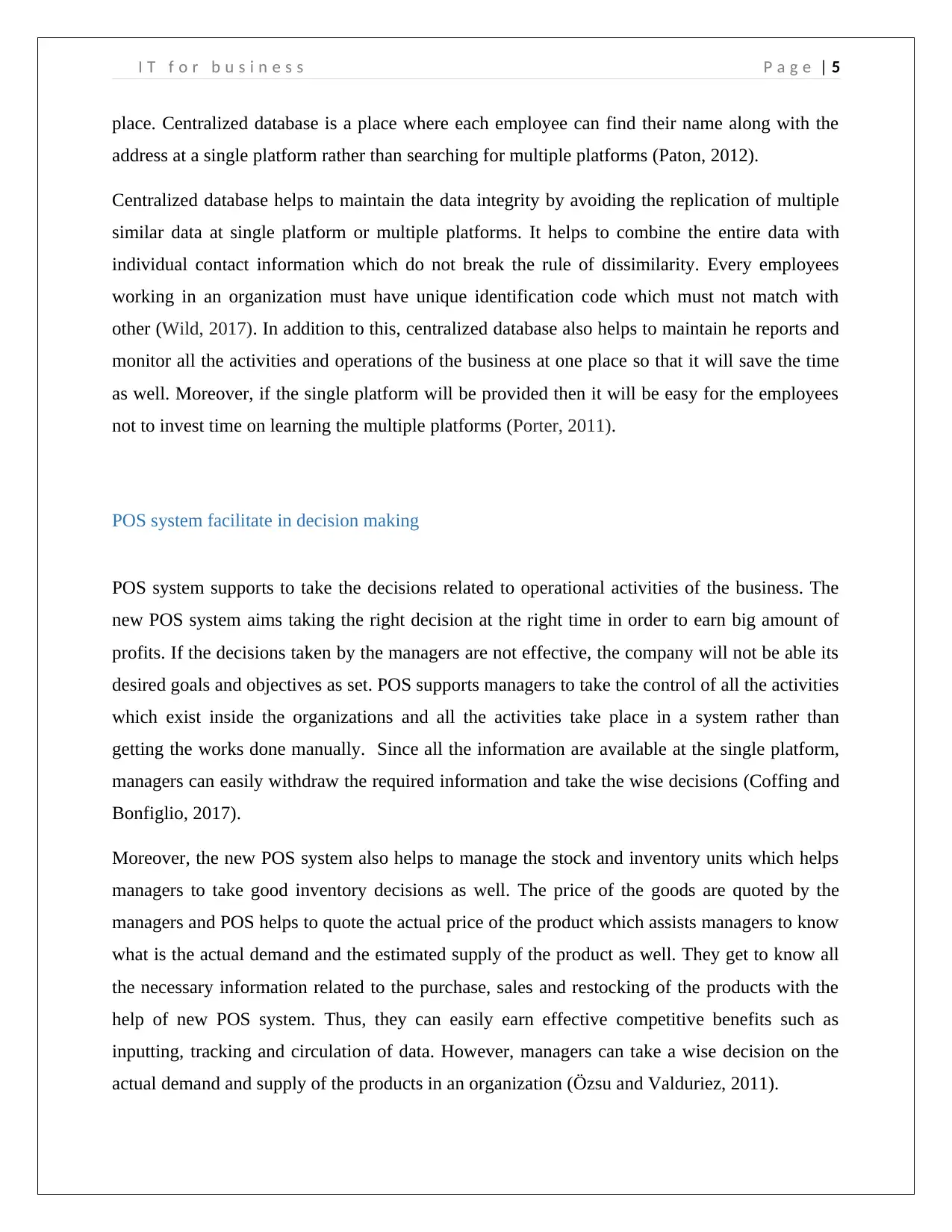
I T f o r b u s i n e s s P a g e | 5
place. Centralized database is a place where each employee can find their name along with the
address at a single platform rather than searching for multiple platforms (Paton, 2012).
Centralized database helps to maintain the data integrity by avoiding the replication of multiple
similar data at single platform or multiple platforms. It helps to combine the entire data with
individual contact information which do not break the rule of dissimilarity. Every employees
working in an organization must have unique identification code which must not match with
other (Wild, 2017). In addition to this, centralized database also helps to maintain he reports and
monitor all the activities and operations of the business at one place so that it will save the time
as well. Moreover, if the single platform will be provided then it will be easy for the employees
not to invest time on learning the multiple platforms (Porter, 2011).
POS system facilitate in decision making
POS system supports to take the decisions related to operational activities of the business. The
new POS system aims taking the right decision at the right time in order to earn big amount of
profits. If the decisions taken by the managers are not effective, the company will not be able its
desired goals and objectives as set. POS supports managers to take the control of all the activities
which exist inside the organizations and all the activities take place in a system rather than
getting the works done manually. Since all the information are available at the single platform,
managers can easily withdraw the required information and take the wise decisions (Coffing and
Bonfiglio, 2017).
Moreover, the new POS system also helps to manage the stock and inventory units which helps
managers to take good inventory decisions as well. The price of the goods are quoted by the
managers and POS helps to quote the actual price of the product which assists managers to know
what is the actual demand and the estimated supply of the product as well. They get to know all
the necessary information related to the purchase, sales and restocking of the products with the
help of new POS system. Thus, they can easily earn effective competitive benefits such as
inputting, tracking and circulation of data. However, managers can take a wise decision on the
actual demand and supply of the products in an organization (Özsu and Valduriez, 2011).
place. Centralized database is a place where each employee can find their name along with the
address at a single platform rather than searching for multiple platforms (Paton, 2012).
Centralized database helps to maintain the data integrity by avoiding the replication of multiple
similar data at single platform or multiple platforms. It helps to combine the entire data with
individual contact information which do not break the rule of dissimilarity. Every employees
working in an organization must have unique identification code which must not match with
other (Wild, 2017). In addition to this, centralized database also helps to maintain he reports and
monitor all the activities and operations of the business at one place so that it will save the time
as well. Moreover, if the single platform will be provided then it will be easy for the employees
not to invest time on learning the multiple platforms (Porter, 2011).
POS system facilitate in decision making
POS system supports to take the decisions related to operational activities of the business. The
new POS system aims taking the right decision at the right time in order to earn big amount of
profits. If the decisions taken by the managers are not effective, the company will not be able its
desired goals and objectives as set. POS supports managers to take the control of all the activities
which exist inside the organizations and all the activities take place in a system rather than
getting the works done manually. Since all the information are available at the single platform,
managers can easily withdraw the required information and take the wise decisions (Coffing and
Bonfiglio, 2017).
Moreover, the new POS system also helps to manage the stock and inventory units which helps
managers to take good inventory decisions as well. The price of the goods are quoted by the
managers and POS helps to quote the actual price of the product which assists managers to know
what is the actual demand and the estimated supply of the product as well. They get to know all
the necessary information related to the purchase, sales and restocking of the products with the
help of new POS system. Thus, they can easily earn effective competitive benefits such as
inputting, tracking and circulation of data. However, managers can take a wise decision on the
actual demand and supply of the products in an organization (Özsu and Valduriez, 2011).
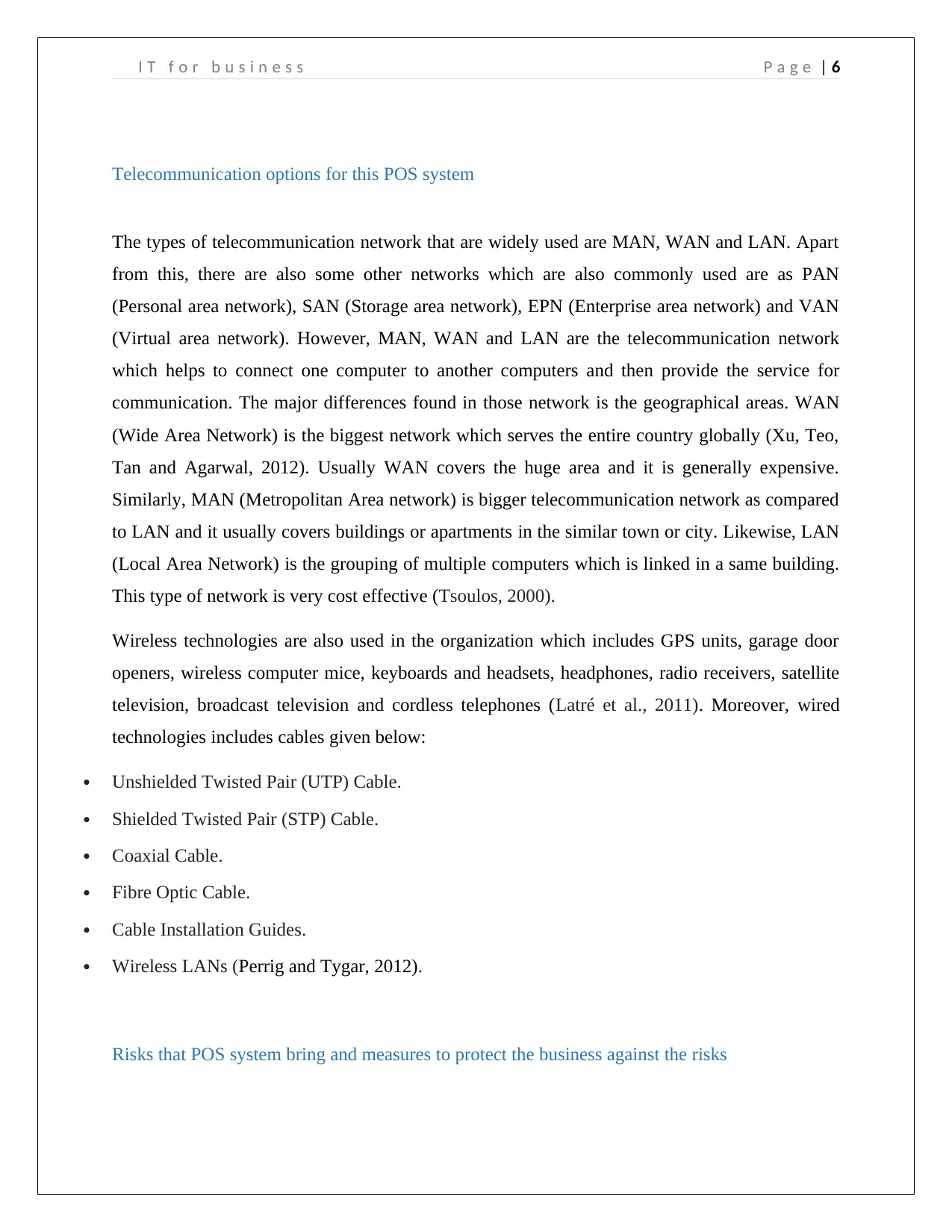
I T f o r b u s i n e s s P a g e | 6
Telecommunication options for this POS system
The types of telecommunication network that are widely used are MAN, WAN and LAN. Apart
from this, there are also some other networks which are also commonly used are as PAN
(Personal area network), SAN (Storage area network), EPN (Enterprise area network) and VAN
(Virtual area network). However, MAN, WAN and LAN are the telecommunication network
which helps to connect one computer to another computers and then provide the service for
communication. The major differences found in those network is the geographical areas. WAN
(Wide Area Network) is the biggest network which serves the entire country globally (Xu, Teo,
Tan and Agarwal, 2012). Usually WAN covers the huge area and it is generally expensive.
Similarly, MAN (Metropolitan Area network) is bigger telecommunication network as compared
to LAN and it usually covers buildings or apartments in the similar town or city. Likewise, LAN
(Local Area Network) is the grouping of multiple computers which is linked in a same building.
This type of network is very cost effective (Tsoulos, 2000).
Wireless technologies are also used in the organization which includes GPS units, garage door
openers, wireless computer mice, keyboards and headsets, headphones, radio receivers, satellite
television, broadcast television and cordless telephones (Latré et al., 2011). Moreover, wired
technologies includes cables given below:
Unshielded Twisted Pair (UTP) Cable.
Shielded Twisted Pair (STP) Cable.
Coaxial Cable.
Fibre Optic Cable.
Cable Installation Guides.
Wireless LANs (Perrig and Tygar, 2012).
Risks that POS system bring and measures to protect the business against the risks
Telecommunication options for this POS system
The types of telecommunication network that are widely used are MAN, WAN and LAN. Apart
from this, there are also some other networks which are also commonly used are as PAN
(Personal area network), SAN (Storage area network), EPN (Enterprise area network) and VAN
(Virtual area network). However, MAN, WAN and LAN are the telecommunication network
which helps to connect one computer to another computers and then provide the service for
communication. The major differences found in those network is the geographical areas. WAN
(Wide Area Network) is the biggest network which serves the entire country globally (Xu, Teo,
Tan and Agarwal, 2012). Usually WAN covers the huge area and it is generally expensive.
Similarly, MAN (Metropolitan Area network) is bigger telecommunication network as compared
to LAN and it usually covers buildings or apartments in the similar town or city. Likewise, LAN
(Local Area Network) is the grouping of multiple computers which is linked in a same building.
This type of network is very cost effective (Tsoulos, 2000).
Wireless technologies are also used in the organization which includes GPS units, garage door
openers, wireless computer mice, keyboards and headsets, headphones, radio receivers, satellite
television, broadcast television and cordless telephones (Latré et al., 2011). Moreover, wired
technologies includes cables given below:
Unshielded Twisted Pair (UTP) Cable.
Shielded Twisted Pair (STP) Cable.
Coaxial Cable.
Fibre Optic Cable.
Cable Installation Guides.
Wireless LANs (Perrig and Tygar, 2012).
Risks that POS system bring and measures to protect the business against the risks
Paraphrase This Document
Need a fresh take? Get an instant paraphrase of this document with our AI Paraphraser
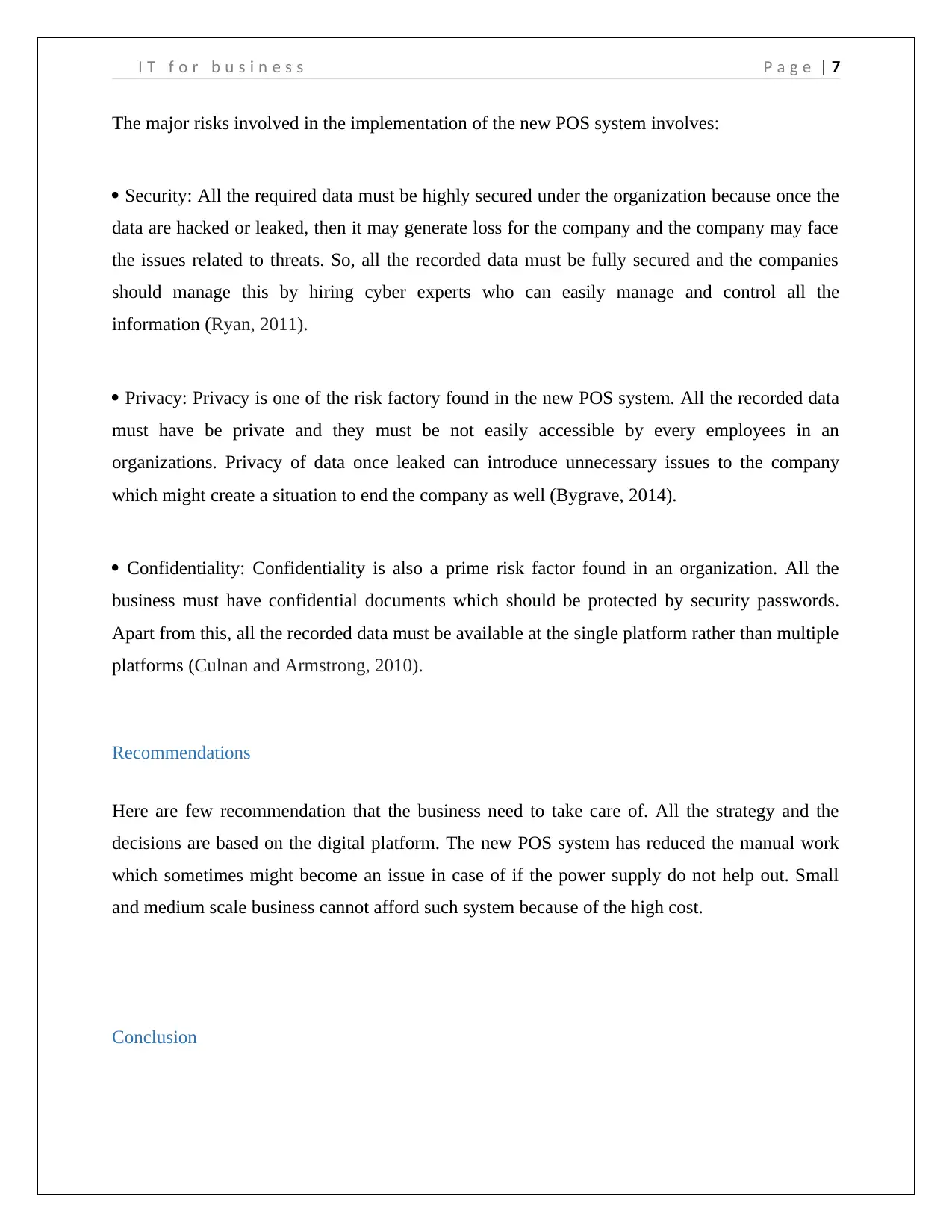
I T f o r b u s i n e s s P a g e | 7
The major risks involved in the implementation of the new POS system involves:
Security: All the required data must be highly secured under the organization because once the
data are hacked or leaked, then it may generate loss for the company and the company may face
the issues related to threats. So, all the recorded data must be fully secured and the companies
should manage this by hiring cyber experts who can easily manage and control all the
information (Ryan, 2011).
Privacy: Privacy is one of the risk factory found in the new POS system. All the recorded data
must have be private and they must be not easily accessible by every employees in an
organizations. Privacy of data once leaked can introduce unnecessary issues to the company
which might create a situation to end the company as well (Bygrave, 2014).
Confidentiality: Confidentiality is also a prime risk factor found in an organization. All the
business must have confidential documents which should be protected by security passwords.
Apart from this, all the recorded data must be available at the single platform rather than multiple
platforms (Culnan and Armstrong, 2010).
Recommendations
Here are few recommendation that the business need to take care of. All the strategy and the
decisions are based on the digital platform. The new POS system has reduced the manual work
which sometimes might become an issue in case of if the power supply do not help out. Small
and medium scale business cannot afford such system because of the high cost.
Conclusion
The major risks involved in the implementation of the new POS system involves:
Security: All the required data must be highly secured under the organization because once the
data are hacked or leaked, then it may generate loss for the company and the company may face
the issues related to threats. So, all the recorded data must be fully secured and the companies
should manage this by hiring cyber experts who can easily manage and control all the
information (Ryan, 2011).
Privacy: Privacy is one of the risk factory found in the new POS system. All the recorded data
must have be private and they must be not easily accessible by every employees in an
organizations. Privacy of data once leaked can introduce unnecessary issues to the company
which might create a situation to end the company as well (Bygrave, 2014).
Confidentiality: Confidentiality is also a prime risk factor found in an organization. All the
business must have confidential documents which should be protected by security passwords.
Apart from this, all the recorded data must be available at the single platform rather than multiple
platforms (Culnan and Armstrong, 2010).
Recommendations
Here are few recommendation that the business need to take care of. All the strategy and the
decisions are based on the digital platform. The new POS system has reduced the manual work
which sometimes might become an issue in case of if the power supply do not help out. Small
and medium scale business cannot afford such system because of the high cost.
Conclusion
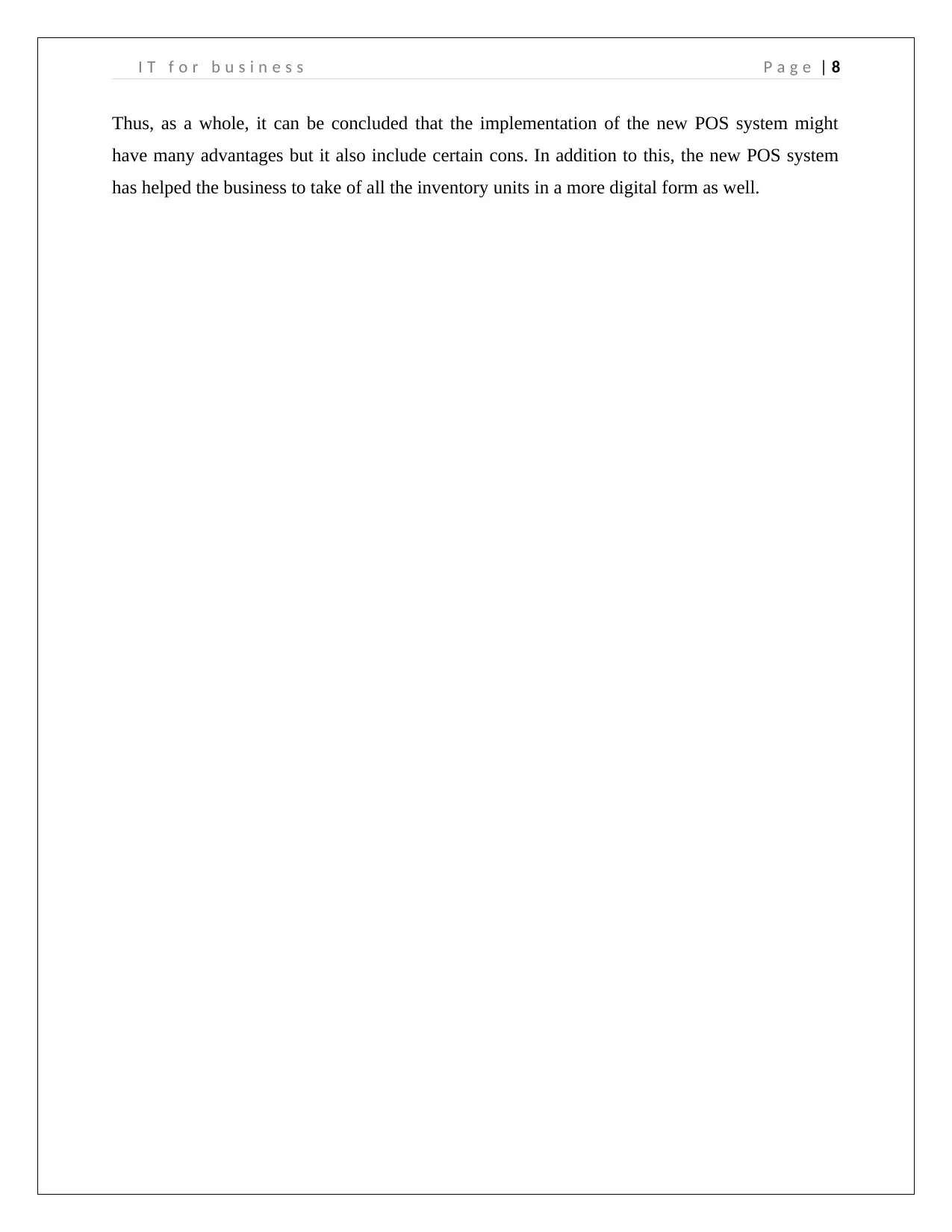
I T f o r b u s i n e s s P a g e | 8
Thus, as a whole, it can be concluded that the implementation of the new POS system might
have many advantages but it also include certain cons. In addition to this, the new POS system
has helped the business to take of all the inventory units in a more digital form as well.
Thus, as a whole, it can be concluded that the implementation of the new POS system might
have many advantages but it also include certain cons. In addition to this, the new POS system
has helped the business to take of all the inventory units in a more digital form as well.
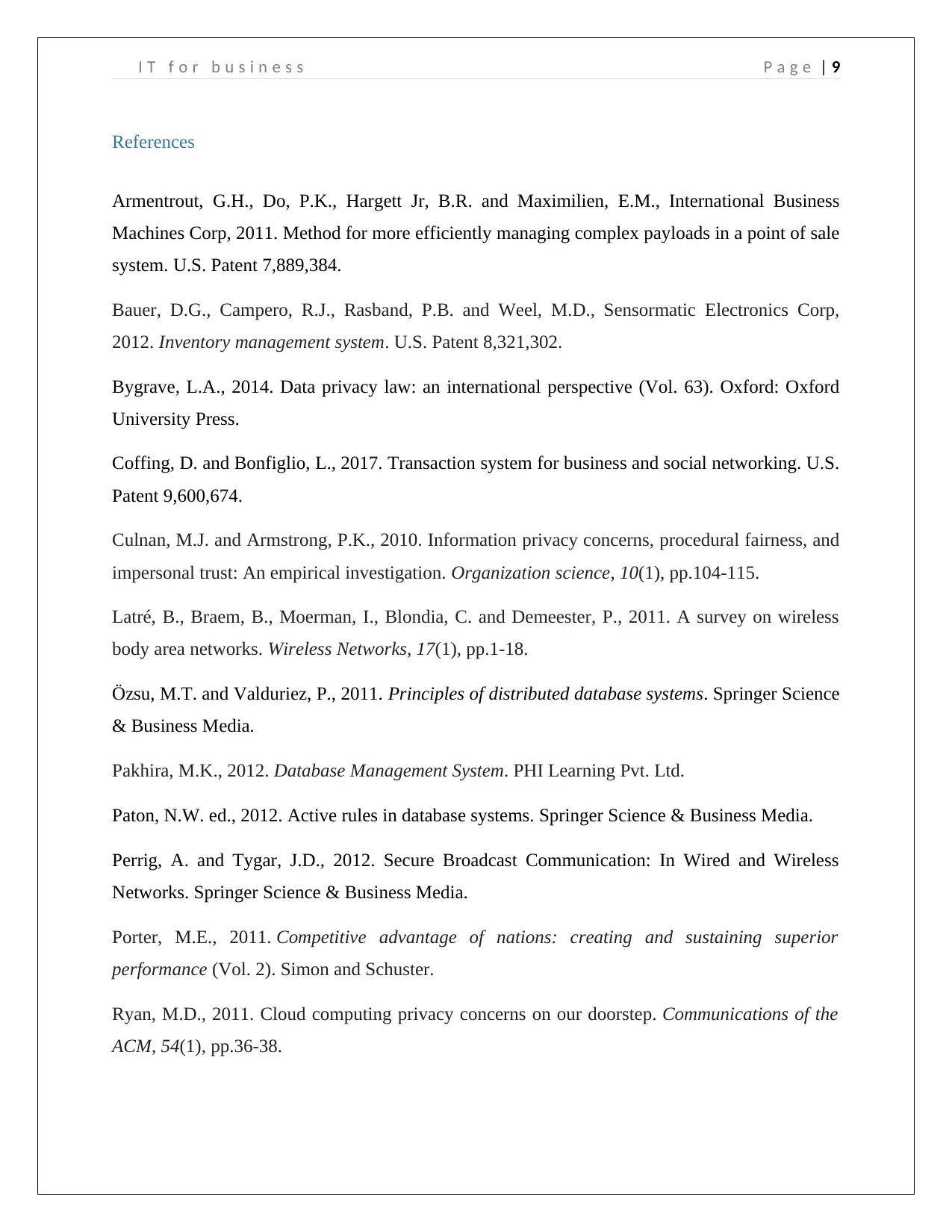
I T f o r b u s i n e s s P a g e | 9
References
Armentrout, G.H., Do, P.K., Hargett Jr, B.R. and Maximilien, E.M., International Business
Machines Corp, 2011. Method for more efficiently managing complex payloads in a point of sale
system. U.S. Patent 7,889,384.
Bauer, D.G., Campero, R.J., Rasband, P.B. and Weel, M.D., Sensormatic Electronics Corp,
2012. Inventory management system. U.S. Patent 8,321,302.
Bygrave, L.A., 2014. Data privacy law: an international perspective (Vol. 63). Oxford: Oxford
University Press.
Coffing, D. and Bonfiglio, L., 2017. Transaction system for business and social networking. U.S.
Patent 9,600,674.
Culnan, M.J. and Armstrong, P.K., 2010. Information privacy concerns, procedural fairness, and
impersonal trust: An empirical investigation. Organization science, 10(1), pp.104-115.
Latré, B., Braem, B., Moerman, I., Blondia, C. and Demeester, P., 2011. A survey on wireless
body area networks. Wireless Networks, 17(1), pp.1-18.
Özsu, M.T. and Valduriez, P., 2011. Principles of distributed database systems. Springer Science
& Business Media.
Pakhira, M.K., 2012. Database Management System. PHI Learning Pvt. Ltd.
Paton, N.W. ed., 2012. Active rules in database systems. Springer Science & Business Media.
Perrig, A. and Tygar, J.D., 2012. Secure Broadcast Communication: In Wired and Wireless
Networks. Springer Science & Business Media.
Porter, M.E., 2011. Competitive advantage of nations: creating and sustaining superior
performance (Vol. 2). Simon and Schuster.
Ryan, M.D., 2011. Cloud computing privacy concerns on our doorstep. Communications of the
ACM, 54(1), pp.36-38.
References
Armentrout, G.H., Do, P.K., Hargett Jr, B.R. and Maximilien, E.M., International Business
Machines Corp, 2011. Method for more efficiently managing complex payloads in a point of sale
system. U.S. Patent 7,889,384.
Bauer, D.G., Campero, R.J., Rasband, P.B. and Weel, M.D., Sensormatic Electronics Corp,
2012. Inventory management system. U.S. Patent 8,321,302.
Bygrave, L.A., 2014. Data privacy law: an international perspective (Vol. 63). Oxford: Oxford
University Press.
Coffing, D. and Bonfiglio, L., 2017. Transaction system for business and social networking. U.S.
Patent 9,600,674.
Culnan, M.J. and Armstrong, P.K., 2010. Information privacy concerns, procedural fairness, and
impersonal trust: An empirical investigation. Organization science, 10(1), pp.104-115.
Latré, B., Braem, B., Moerman, I., Blondia, C. and Demeester, P., 2011. A survey on wireless
body area networks. Wireless Networks, 17(1), pp.1-18.
Özsu, M.T. and Valduriez, P., 2011. Principles of distributed database systems. Springer Science
& Business Media.
Pakhira, M.K., 2012. Database Management System. PHI Learning Pvt. Ltd.
Paton, N.W. ed., 2012. Active rules in database systems. Springer Science & Business Media.
Perrig, A. and Tygar, J.D., 2012. Secure Broadcast Communication: In Wired and Wireless
Networks. Springer Science & Business Media.
Porter, M.E., 2011. Competitive advantage of nations: creating and sustaining superior
performance (Vol. 2). Simon and Schuster.
Ryan, M.D., 2011. Cloud computing privacy concerns on our doorstep. Communications of the
ACM, 54(1), pp.36-38.
Secure Best Marks with AI Grader
Need help grading? Try our AI Grader for instant feedback on your assignments.
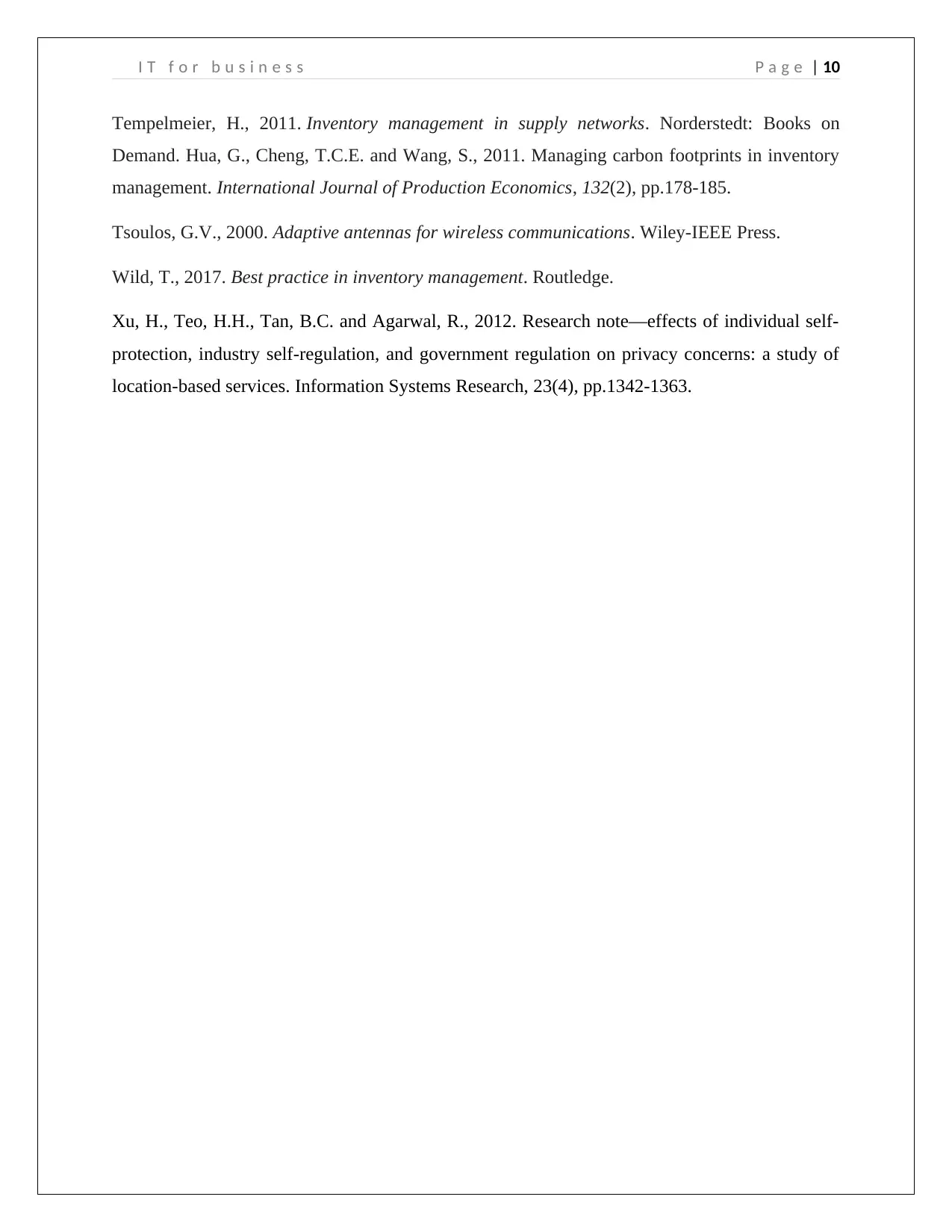
I T f o r b u s i n e s s P a g e | 10
Tempelmeier, H., 2011. Inventory management in supply networks. Norderstedt: Books on
Demand. Hua, G., Cheng, T.C.E. and Wang, S., 2011. Managing carbon footprints in inventory
management. International Journal of Production Economics, 132(2), pp.178-185.
Tsoulos, G.V., 2000. Adaptive antennas for wireless communications. Wiley-IEEE Press.
Wild, T., 2017. Best practice in inventory management. Routledge.
Xu, H., Teo, H.H., Tan, B.C. and Agarwal, R., 2012. Research note—effects of individual self-
protection, industry self-regulation, and government regulation on privacy concerns: a study of
location-based services. Information Systems Research, 23(4), pp.1342-1363.
Tempelmeier, H., 2011. Inventory management in supply networks. Norderstedt: Books on
Demand. Hua, G., Cheng, T.C.E. and Wang, S., 2011. Managing carbon footprints in inventory
management. International Journal of Production Economics, 132(2), pp.178-185.
Tsoulos, G.V., 2000. Adaptive antennas for wireless communications. Wiley-IEEE Press.
Wild, T., 2017. Best practice in inventory management. Routledge.
Xu, H., Teo, H.H., Tan, B.C. and Agarwal, R., 2012. Research note—effects of individual self-
protection, industry self-regulation, and government regulation on privacy concerns: a study of
location-based services. Information Systems Research, 23(4), pp.1342-1363.
1 out of 11
Related Documents
Your All-in-One AI-Powered Toolkit for Academic Success.
+13062052269
info@desklib.com
Available 24*7 on WhatsApp / Email
![[object Object]](/_next/static/media/star-bottom.7253800d.svg)
Unlock your academic potential
© 2024 | Zucol Services PVT LTD | All rights reserved.



